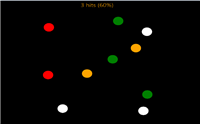Contents tagged with MOT
-

MOT is a famous experimental paradigm used to study how our visual system tracks multiple moving objects. The paradigm was developed by Pylyshyn and Storm in 1988 and subsequently adapted in numerous studies. The common finding over these studies is that there is a limited number of moving objects that the visual system can track in a parallel.
There are two prominent theories explaining a limited capacity in the MOT task: the earliest FINST theory (Pylyshyn 1989, 1994) postulating that brain has a limited (around 4) of tracking 'pointers' that can be attached to moving objects (Pylyshin et al). Another theory, proposed and tested by Yantis in 1992 , suggests that all tracking objects are grouped into one higher order group with each object making a vertex in a virtual polygon.
We developed two EventIDE templates of the MOT task, with two types of participant's response taken after end of a motion. The first template replicates the original Pylyshyn 's paradigm, where a Yes-No response indicates whether a single probed object belongs to a subset of tracking objects. The second template allows participant to indicate all tracking objects with a mouse. The later response type became a standard in the MOT recent studies.
The template contain a code that generates unpredictable trajectories for occlusion-free motion of multiple objects. Trajectory generation is a random process controlled by several initial parameters that can be customized. In addition, the templates demonstrate how to use recurrent events to create a time-precise animation with EventIDE.
Submitted by on 16 Dec 2012
-
Multiple object tracking (MOT) paradigm
This is template for the famous MOT paradigm (Pylyshyn&Storm, 1998 Scholl&Pylyshyn, 1999). The template contains a code generating unpredictable trajectories for occlusion-free motion of multiple objects. Trajectory generation is a random process controlled by several initial parameters that can be customized. In adddition, the template demonstrates how to use reccurent events to create a time-precise animation with EventIDE.
